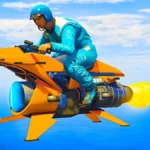Canoeing encompasses two distinct disciplines: flatwater canoeing and canoe slalom. Flatwater canoeing takes place on calm bodies of water such as lakes, ponds, or slow-moving rivers. It offers a tranquil and leisurely experience, allowing paddlers to appreciate the serenity of the water while using long, narrow canoes designed for straight-line paddling.
On the other hand, canoe slalom is a competitive sport where athletes navigate a challenging course of gates on fast-flowing rivers. The objective is to complete the course swiftly without missing or touching any gates, requiring exceptional agility and precision. Canoe slalom can be an exhilarating sport, and the canoes used are designed for maneuverability.
Canoe Flatwater
Canoe flatwater is a type of canoeing that is done on calm water, such as a lake or river. Flatwater canoeing is a popular recreational activity, and it is also a competitive sport. Flatwater canoe races are typically held on courses that are 200 meters, 500 meters, or 1000 meters long.
To compete in a flatwater canoe race, you will need to register with a local or national canoeing federation. Once you are registered, you will be able to compete in races at your level.
Also Read: Asian Games 2023: Indian medals tally
History of Canoe Flatwater
The history of flatwater kayaking dates back to early civilizations when kayaks were used for transportation and trade. However, canoe racing only began to develop into a sport in the early 19th century. In 1866, British explorer and writer John MacGregor founded the Royal Canoe Club, the first canoeing organization. MacGregor is credited with transforming traditional hunting and fishing boats into pleasure craft.
In the early 20th century, canoe racing began to expand to other parts of the world, including Europe and North America.The first international canoe racing association, the International Representative Office for Canoeing (IRK), was founded in 1924. In 1946 the IRK was renamed the International Canoe Federation (ICF).
The canoe debuted at the 1924 Paris Olympics as a demonstration sport. It became a full Olympic sport at the 1936 Berlin Games. At the 1948 Olympics in London, women competed in flat-water kayaking for the first time, but only in kayaks.Only from 2020 will women be able to compete for medals in kayak sprints. Flat water canoeing is becoming one of the most popular Olympic sports. Kayakers from around the world compete for medals in various competitions including: K-1 (single kayak), K-2 (double kayak), K-4 (four-person kayak), C-1 (single kayak), and C-2 ( double kayak). Flat water kayaking is also a popular recreational sport. Millions of people around the world kayak on lakes, rivers and oceans.Flat water kayaking is a great way to get exercise and spend time outdoors.
Techniques of Canoe Flatwater
The basic paddling technique for flatwater canoeing is as follows:
- Sit in the center of the canoe and grip the paddle with both hands.
- Place the paddle in the water on one side of the canoe.
- Push the paddle away from you with your arms and core muscles.
- Rotate your torso towards the other side of the canoe as you push the paddle.
- Repeat steps 3-4 on the other side of the canoe.
Canoe Slalom
Canoe slalom is an exciting and challenging water sport where athletes paddle a canoe or kayak through a course of gates set up on a fast-flowing, whitewater river. The objective is to navigate the course as quickly as possible without touching or missing any gates. Canoe slalom requires a combination of paddling skills, strength, agility, and precise control of the canoe or kayak.
Canoe slalom is a competitive Olympic sport and is known for its fast-paced action and thrilling races. It’s a test of both physical and technical abilities, making it a favorite among water sports enthusiasts and competitors.
History of Canoe Slalom
Origins: The sport of canoe slalom has its origins in canoe racing and river navigation. In the early 20th century, canoeists began to challenge themselves by navigating through natural obstacles and currents on rivers.
Formation of the International Canoe Federation (ICF): The International Canoe Federation (ICF) was founded in 1924, and it played a pivotal role in the development and organization of canoeing sports, including slalom. The ICF established standardized rules and regulations for canoeing competitions.
First Competitions: The first documented canoe slalom competition took place in Switzerland in 1932. However, the sport didn’t gain widespread recognition until the 1940s and 1950s when organized events became more common.
Olympic Debut: Canoe slalom made its Olympic debut at the 1972 Munich Olympics for men and the 1992 Barcelona Olympics for women. Since then, it has been a regular part of the Olympic program, showcasing the sport to a global audience.
Evolution: Over the years, canoe slalom courses have become more challenging, featuring a combination of upstream and downstream gates, as well as various whitewater obstacles. Athletes’ skills and equipment have also evolved to meet the demands of the sport.
Also Read: Top 10 Sports of Olympics: History and Timeline
Techniques of Canoe Slalom
1.Forward paddling: This is the most common type of paddling in canoe slalom. To forward paddle, place the paddle in the water on one side of the canoe and push it away from you with your arms and core muscles. Rotate your torso towards the other side of the canoe as you push the paddle. Repeat steps 3-4 on the other side of the canoe.
2.Sweep strokes: Sweep strokes are used to turn the canoe. To do a sweep stroke, place the paddle in the water on one side of the canoe and sweep it across the front of the canoe to the other side. This will cause the canoe to turn in the direction of the paddle stroke.
3.Draw strokes: Draw strokes are also used to turn the canoe, but they are more powerful than sweep strokes. To do a draw stroke, place the paddle in the water on one side of the canoe and pull it towards you. This will cause the canoe to turn in the direction of the paddle stroke.
4.Bow rudder: The bow rudder is a technique used to control the direction of the canoe at low speeds. To do a bow rudder, place the paddle in the water at the bow of the canoe and angle it towards the side of the canoe that you want to turn towards. This will cause the canoe to turn in the desired direction.
Conclusion
From the article it is concluded that Canoeing is a great way to explore the outdoors and get exercise. It is also a relatively low-impact activity, making it suitable for people of all ages and fitness levels. If you are interested in trying canoeing, there are a number of resources available to help you get started.




























